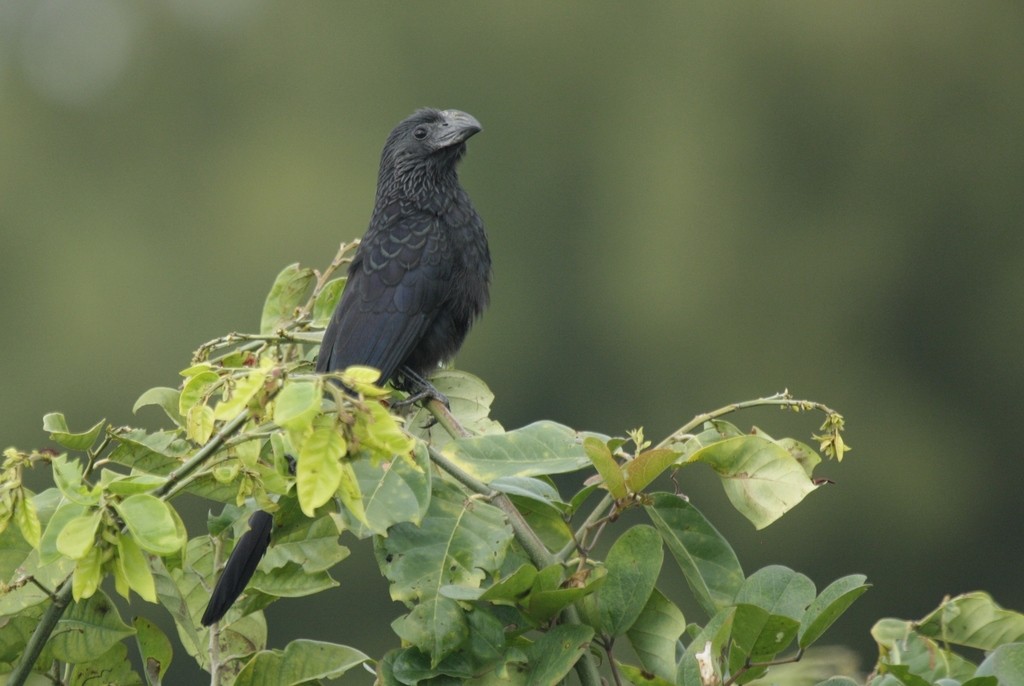Groove-billed Ani
A species of Anis Scientific name : Crotophaga sulcirostris Genus : Anis
Groove-billed Ani, A species of Anis
Botanical name: Crotophaga sulcirostris
Genus: Anis
Content
Description People often ask General Info
 Photo By silversea_starsong , used under CC-BY-NC-4.0 /Cropped and compressed from original
Photo By silversea_starsong , used under CC-BY-NC-4.0 /Cropped and compressed from original Description
The groove-billed ani (Crotophaga sulcirostris) is a tropical bird in the cuckoo family with a long tail and a large, curved beak. It is a resident species throughout most of its range, from southern Texas, central Mexico and The Bahamas, through Central America, to northern Colombia and Venezuela, and coastal Ecuador and Peru. It only retreats from the northern limits of its range in Texas and northern Mexico during winter. The groove-billed ani is about 34 cm (13 in) long, and weighs 70–90 g (2.5–3.2 oz). Wingspan ranges from 41-46 cm (16-18 in). It is completely black, with a very long tail almost as long as its body. It has a huge bill with lengthwise grooves running the length of the upper mandible. It is very similar to the smooth-billed ani, some specimens of which have bills as small as the groove-billed and with grooves on the basal half. The two species are best distinguished by voice and range. In flight, the ani alternates between quick, choppy flaps and short glides. Like other anis, the groove-billed is found in open and partly open country, such as pastures, savanna, and orchards. It feeds largely on a mixed diet of insects, seeds, and fruits. The groove-billed ani lives in small groups of one to five breeding pairs. They defend a single territory and lay their eggs in one communal nest. All group members incubate the eggs and care for the young. 
Size
30-36 cm (12-14 in)
Nest Placement
Tree
Feeding Habits
Groove-billed Ani's diet primarily includes large insects, as well as small animals, fruits, and seeds. These birds forage on the ground or in vegetation, often capturing grasshoppers, beetles, and other bugs through quick pounces and short flights. They also eat parasites from livestock and can raid nests for eggs, complementing their diet by following cattle or army ants to find prey.
Habitat
Groove-billed Ani inhabit open and semi-open terrains in tropical lowlands and lower foothills, predominantly in grasslands, savannas, and overgrown pastures with interspersed shrubbery. Adapted to drier ecosystems at altitudes favoring their climatic and vegetative preferences, they forage in open areas and find seclusion within dense foliage. Although they maintain year-round territories, they may gather by riverside wetlands during droughts.
Nest Behavior
Groove-billed Ani displays communal nesting behavior with both males and females participating in building the nest. Mates work together, with males supplying materials. Nest construction can occur at varying heights, and groove-billed Ani's undertake cooperative breeding, sharing in the incubation and care of the young.
Nest Characteristics
Groove-billed Ani's nest is commonly located in thick vegetation within a tree or bush, ranging from 2 to 43 feet above the ground. The nests are shallow bowls approximately 11.8 inches in width and 3 inches in height, constructed from twigs, weeds, grass, palm leaves, and roots, with a lining of green leaves.
Dite type
Insectivorous
People often ask
General Info
Feeding Habits
Bird food type
Sounds
Call
Recording location: Mexico
Behavior
Groove-billed Ani showcase remarkable social behavior, living and cooperating in communal groups that can include multiple pairs. These groups engage in shared daily activities, such as foraging for insects and fruits, which constitute their primary diet. Their interaction with the environment is notably collaborative; groove-billed Ani construct a communal nest where all participating females deposit their eggs, and both incubation and chick-rearing responsibilities are shouldered by the entire group. This joint-effort nesting strategy is a distinctive behavior that sets groove-billed Ani apart from many other bird species. After fledging, juveniles stay within their natal group for weeks before venturing out independently, further illustrating the species' strong social bond and collective lifestyle.
Species Status
Not globally threatened.
Scientific Classification
Phylum
Chordates Class
Birds Order
Cuckoos and Relatives Family
Cuckoos Genus
Anis Species
Groove-billed Ani